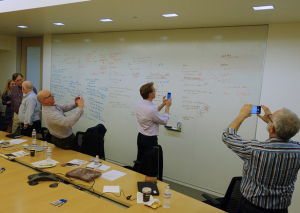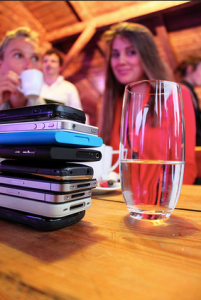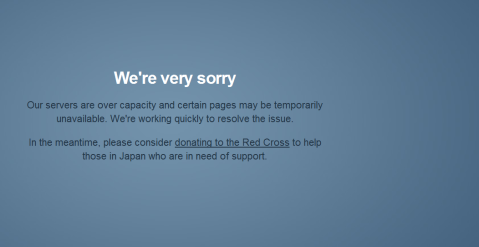The social cost of smartphones
Posted on: June 6, 2015
Where did face-to-face human interaction go? Where did paying attention to each other go? Where did living in the moment go?
“Smartphones have impacted almost all walk of human life. The prominent areas, where impacts of Smartphone are obvious include business, education, health and social life. Mobile technology has drastically changed the cultural norms and behaviour of individuals.” (Sarwar & Soomro, 2013)
- 51% of adults and 65% of teens say they have used their Smartphone while socialising with others.
“This addiction to Smartphones is impacting the social and family life and creating frictions in our lives.”
- 37% of adults and 60% of teens admit they are highly addicted to their Smartphone.

Law abiding citizen. Mo Riza/ CC BY

Socialising. Björn Bechstein/CC BY-ND
- 23% of adults and 34% of teens have used their Smartphone during mealtimes.
Awareness of addiction leads to…
References
Facts & Figures
Sarwar M, Soomro T 2013, ‘Impact of Smartphone’s on Society’, European Journal of Scientific Research, vol,98, no.2, pp216-226.
Photographs
Beschstein, B 2011, ‘Communicating’ photograph, October 29 via Flickr, Creative Commons Non Derivatives License.
Bradhoc 2012, ‘Cell phone series’ photograph, June 5 via Flickr, Creative Commons Attribution License.
G, M 2014, ‘Little & Large’ photograph, August 21 via Flickr, Creative Commons Attribution License.
G, M 2014, ‘Love (of technology)’ photograph, November 22 via Flickr, Creative Commons Attribution License.
Jurvetson, S 2015, ‘Reflections on the new Machine Age — technology, inequality and the economy’ photograph, March 12 via Flickr, Creative Commons Attribution License.
Klauke, S 2013, ‘Cell Phone Business’ photograph, January 18 via Flickr, Creative Commons Noncommercial Non Derivatives License.
Lawler, D 2012, ‘Class of 2012’ photograph, June 14 via Flickr, Creative Commons Attribution Noncommercial Non Derivatives.
McIntyre, G 2012, ‘Phonestacking’ photograph, July 12 via Flickr, Creative Commons Attribution License.
Molano, D 2014, ‘Yo’ photograph, January 26 via Flickr, Creative Commons Attribution Non Commerical Non Derivatives License.
M01229 2012, ‘Tuckered out, but still needs the phone’ photograph, December 29 via Flickr, Creative Commons Attribution License.
N.L.M, K 2013, ‘Give me a ring’ photograph, August 20 via Flickr, Creative Commons Attribution Noncommercial License.
N.L.M, K 2013, ‘Informal Gluttony’ photograph, July 19 via Flickr, Creative Commons Attribution Noncommercial License.
Nye, M 2012, ‘This is Santa Cruz’ photograph, November 18 via Flickr, Creative Commons Attribution Noncommercial Non Derivatives License.
Riza, M 2006, ‘Textbreak’ photograph, June 22 via Flickr, Creative Commons Attribution License.
3D
Posted on: May 29, 2011
- In: Media | Technology
- Leave a Comment
Mashable covers the integration of 3D and youtube. Technology aimed at inhancing the viewers experience. The article reveals:
Mozilla Firefox, YouTube and Nvidia have teamed up to bring HTML5-based stereoscopic 3D video to owners of Nvidia’s 3D Vision-enabled hardware.
We’ve seen 3D movies and then 3D TV but now the internet is joining in. This raises the question of technology movement and the transfer of technology to different platforms.
The article links to 3DLIVE which shows photos,videos,youtube,apps all in 3D. The inclusion of the video
adds to the article. However it doesn’t take from the fact that its a fairly short article.
CNN article (blog) covered the issue, talking more about the consumer, the downfalls and the developments.
It works only on Firefox 4. Also, 3D Vision, a software/hardware package that costs about $150, must be installed on a compatible PC. And of course, users must wear 3D glasses, which come with the kit.
So, it’s only for people who really, really want it. And aren’t on a Mac. That doesn’t mean it won’t succeed — indeed, it most likely means that Nvidia (NVDA) will be able to keep its price points high for some time to come.
The company forecasts that there will be 40 million PCs with 3D Vision installed by 2015.
The article then talks about the possibilities and how it will ‘explode’. The brief article was informative but lacked length.
ReelSeo also covered this. Despite the conversational tone there is plenty of information and the use of headings allows the information to be easily understood. The article also criticises the developments:
Really, this is still more of an experiment than a full-fledged initiative I imagine. After all, you need a good amount of hardware and the specific software (which we all have by now, right?). On top of that there are only 6,000 or so 3D videos on YouTube at present so it’s not a major drive.
This differs from previous articles which only talk about the techology.
However all the articles seem to agree that
It’s bound to start taking off
With all the developments in technology from health to science to cars to internet and social networking, there is no telling what the future holds. We have already seen the internet’s role in disasters, the explosion of social networking and inventions of new gadgets but audience interaction and developments in technology allow limitless opportunities. We don’t know what’s next in technology, we will have to wait and see.
TechnoMovement
Posted on: May 29, 2011
- In: Media | Technology
- Leave a Comment
Advancements in bandwidth and technology has opened up new doors and experiences, this was proved at the Detroit Music Festival. The Detroit Free Press covered the latest development, unlike the festival zoo who simply covered the festival itself.
The Detroit Free Press article discussed the difference between the other festivals:
The concept of live concert streaming certainly isn’t new, and video feeds of events such as the Coachella festival have been heralded as recent Internet milestones.
But Movement’s move into full-time, three-day, five-stage audio streaming does emphasize a new era’s arrival, made possible by advancements in bandwidth and technology.
Saturday it symbolized the meeting of music and high tech that has long been the festival’s calling card. Movement’s streams had drawn about 5,000 global listeners by mid-afternoon, said officials with Awdio, the French tech firm behind the webcasts.
The article also included a picture from the festival:

- Jaafar Zamat , 21, of Detroit busts a move at Hart Plaza today. / JARRAD HENDERSON/Detroit Free Press
The article includes quotes and information. The article discusses the developments since the festival started.
The Festival Zoo article covers facts and figures, places to stay and also includes videos of the performances.
An article on synthtopia included times and dates of performances, also mentioning the developments in ISP technology:
“ISP Technologies is excited to help make the festival’s fifth stage a possibility by providing our new High Definition Line Array System HDL4210 for the stage,”
The short article included quotes and information, however it is rather brief compared to the detroit free press article.
The festival and developments got some coverage but not by many other media publications. This development raises questions about the future of technology, the audience’s experience changed through these developments. This could be exlpored in another article.
Futuristic
Posted on: May 26, 2011
- In: Media | Technology
- Leave a Comment
The latest technology developments for cars has got the media buzzing. Cohda Wireless, manufactures the dedicated short-range communications (DSRC) technology, the newest in car technology. The Sydney Morning Herald posted an article describing the technology that allows cars to ‘talk’ to eachother and avoid crashes, this is because the car has 360 degree awareness. The article included a quote explaining the technology.
“Essentially it allows (DSRC) cars to talk to each and exchange information about the position and speed they are heading,” chief executive Paul Gray
The brief article mentioned the impact it will have on safety and hopefully save lives. The logic being that:
“Roads don’t kill people … people’s inattention causes accidents.”
The technology is predicted to be released by 2015.
The article informs the viewer however it lacks depth. Other stories about the impact of the technology or the trials and practises could be made, otherwise more information about the technology as the Sydney Morning Herald talked about a specific car accident instead of the technology. Although it is relevant that as the developments will help save lives.
It seems that the media went off the press release and have no further information yet as Computerworld and Yahoo are exactly the same as the Sydney Morning Herald, similar to many other sites. So really all of them just went off that basic information. The media has a chance to find out more information, if they want to be different from every other publication they need more or at least some angle to increase interest. The topic itself is interesting but adding in pictures or possibly information of how the technology came to be could be a new avenue.
McLibel
Posted on: May 26, 2011
- In: Media | Technology
- Leave a Comment
Perhaps the most interesting use of technology is the case of McLibel where two people in the UK were able to fight against McDonalds. Although it took a toll, the internet allowed them to spread the message without McDonalds controlling them.
They created the site http://www.mcspotlight.org/ which allowed them to post the truth and facts, against McDonalds who was in the process of a trial with the two citizens.
In the end it paid off, the court case is published on their site with the end result:
The verdictwas devastating for McDonald’s. The judge ruled that they ‘exploit children’ with their advertising, produce ‘misleading’ advertising, are ‘culpably responsible’ for cruelty to animals, are ‘antipathetic’ to unionisation and pay their workers low wages. But Helen and Dave failed to prove all the points and so the Judge ruled that they HAD libelled McDonald’s and should pay 60,000 pounds damages. They refused and McDonald’s knew better than to pursue it. In March 1999 the Court of Appeal made further rulings that it was fair comment to say that McDonald’s employees worldwide “do badly in terms of pay and conditions”, and true that “if one eats enough McDonald’s food, one’s diet may well become high in fat etc., with the very real risk of heart disease.”
As a result of the court case, the Anti-McDonald’s campaign mushroomed, the press coverage increased exponentially, this website was born and a feature length documentarywas broadcast round the world.
The legal controversy continued. The McLibel 2 took the British Government to the European Court of Human Rights to defend the public’s right to criticise multinationals, claiming UK libel laws are oppressive and unfair that they were denied a fair trial. The court ruled in favour of Helen and Dave: the case had breached their their rights to freedom of expression and a fair trial.
Who said ordinary people can’t change the world?
Of course the media had something to say about the case. Helen and Dave opened up in the documentary McLibel about the misrepresentation of them in the media as most of the media use McDonalds as sponsors or support. However the media did vary in opinions:
“when your product is as dull as a hamburger, you need something more if you want to bestride the planet. And what McDonald’s has is a reputation.”
Daily Telegraph
Some interesting facts on the McSpotlight site such as:

McDonald's use meat from 10% of the world's cattle."a very real risk of heart disease" for very regular, long-term McDonald's customers.
The site has everything from facts about McDonalds, to all the details about the case and their dealings with the media and cencorship.
In the end the facts were clear as well as the injustice.
“we pride ourselves that we have free speech, but in reality that simply isn’t the case”. Keir Starmer, defendants’ voluntary barrister.
“McDonald’s exploit children by using them, as more susceptible subjects of advertising, to pressurise their parents into going to McDonald’s.” Judge’s verdict
McSpotlight Internet site accessed 2.2 million times in week following verdict.
This is interesting as it highlights how the internet has allowed two people’s struggle with a makor corporation to be known globally. Without this exposure they wouldn’t have been able to spread the message or support.
The most amazing part of the site is the press page which links to the documentary as well as other pages that inform the public on the situation. This site is important because the media’s job is to inform but the internet allowed these two citizens to spread their message regarding intimidation of major companies, the lying of the media and advertising and basically allowing the public to be informed of the TRUTH!
One of the most recent mentions of this caseis in the article in the Business section of the Financial Post, oddly enough in relation to Julian Assange and the wikileaks. It makes sense as both are seen as going against a major power and are simply trying to spread the truth. The article also mentions the use of technology.
We spoke about how technology has changed the way the media cover stories. We then talked about how technology is changing the way in which lawyers can react to such stories.
Julian Assange is quoted –
“Everyone makes this covenant with the state, that we allow them to have secrets so that they can better rule in our interests. Of course, that’s a covenant which has got to be policed.”
The Julian Assange case mirrors similar aspects of the McLibel case which the writer notes later:
Mr. Stephens has worked on a broad range of freedom of speech issues over the years. Some of his notable cases include successfully defending an artist who reproduced British bank notes in contravention of British law, representing James Hewitt with regards to allegations of his affair with Diana, Princess of Wales, and advising Helen Steel and David Morris — the so-called “McLibel Two” activists who were sued by McDonalds after publishing a pamphlet critical of the company.
At the time of the case the New York Times covered the international issue labelling it as ‘Britain’s Big ”McLibel Trial” Its McEndless Too’. The writer seems fairly hostile towards the case, the first line making it fairly obvious:
Even after two grueling, often grindingly tedious years, the case popularly known as the McLibel trial is very much a study in extremes
The article seems very unimpressed with the case using words such as ‘unamused’ in relation to McDonalds. Stories that could be written could be from the public perspective, the health aspect. The big scary company vs the two underdogs is somewhat portrayed in the documentary. However the case and the situation justifies this.
A good example of media coverage is the CNN international section where they portray Helen and Dave as unemployed activists who got a boost from an ‘epic libel suit’. The bias perspective is obvious from the first sentence. The writer calls the case a ‘Big-Mac bashing quest’. Its clear from the use of language that the writer doesn’t like Helen and Dave but then again, they don’t directly say that McDonalds is better.
In the end the McLibel case is an example of the use of technology spreading the message and allowing the public to participate. Technology allows truth to be spread but there is always the media and the different views telling the public what to think.
















 This is reaching a younger and wider audience, raising awareness and asking for help. It was quite bizarre to see this at first as it was incorporated with the over capacity notice but as you look into it there is everything from newspapers to blogs that covered this issue. This is because it is a conflict and has human interest. It’s not recent, as in the past week but things such as the tumblr message remind us of the impact and consequence of the disaster.
This is reaching a younger and wider audience, raising awareness and asking for help. It was quite bizarre to see this at first as it was incorporated with the over capacity notice but as you look into it there is everything from newspapers to blogs that covered this issue. This is because it is a conflict and has human interest. It’s not recent, as in the past week but things such as the tumblr message remind us of the impact and consequence of the disaster.